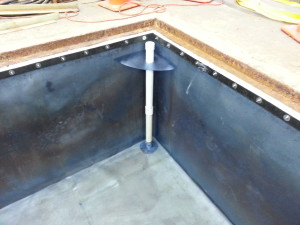Simple Leak Detection For Drop In Liners
One of the features of a drop in liner is that the PVC liner is not bonded directly to the tank or substrate wall. Besides the benefits of not having to sand blast, do extensive prep work, install the liner yourself, no cure time, etc., by not being bonded there is a natural space between the liner and the tank wall that allows for easy leak detection versus a bonded liner or applied coating systems. There are several leak detection systems that are simple to install and very inexpensive to incorporate with your drop in liner.
Liquid sensing probes are a common method of leak detection. In a corner, or several corners, these probes can be placed behind the liner. Typically they run through a conduit pipe that is installed between the liner and tank wall. The probes are connected to an alarm system that will trigger when a leak is detected.
In concrete sumps or pits another method is to install a PVC pipe that provides an access point for monitoring. The pipe can be placed behind the liner or a sealed boot can be installed proving an access point for the pipe to pass through the liner. Periodically the pipe can be inspected for any liquid behind the liner. This can be done as simply as putting a measuring stick or even a line of string down the pipe and checking for any moisture on the stick or string.
As with most things in the life, the simpler the better. On a metal or plastic tank a small hole can be drilled into the corner or corners. A simple valve is threaded into this hole. Periodically the valve is opened to see if any solution comes out indicating a leak of the liner.
At this point it is then a matter of determining the source of the leak and making necessary repairs. These types of simple leak detection systems though can identify such a problem and allow for action to be taken before it develops into something more catastrophic.
Tags: accessories, installation, leak detection
